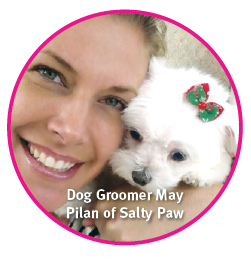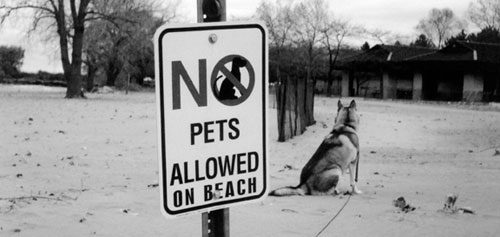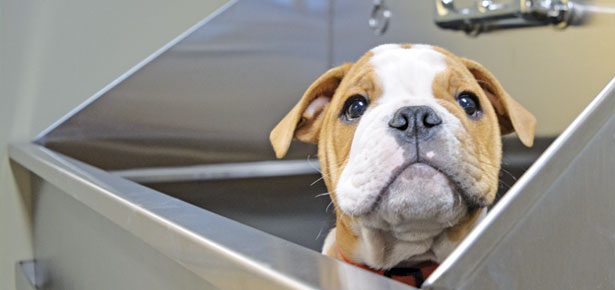

Turn Your Love of Dogs Into A Career
From grooming to walking, there's a dog job for everyone
We all love dogs, but have you ever flirted with the idea of working with animals full‑time? From dog walkers to pet photographers and veterinary technicians, thousands of animal lovers have translated their passion for pets into a successful profession. And while these jobs are wildly different, there are some common traits needed in each pet‑focused career: Caring, kindness, discipline and—above all else—patience. Sort of sounds like raising a puppy doesn't it?
Dog Groomer
When May Pilan was asked to cut and dye the coats of Standard Poodles to match the models walking the runway for Isaac Mizrahi's fall 2011 New York Fashion Week show, she didn't blink an eye. Pilan and her team at The Salty Paw in New York City trimmed stylish bows into the furry sides of the canines and tinted their fur a bright pink with non-toxic dye to match the clothing creations.
As one of the city's leading dog groomers, Pilan is often tasked with transforming her canine clients based on their owners’ creative visions. She's created chic panda and lion cuts and is known for her funky and unique “full body Mohawk” styles, much like Ryan Gosling’s dog, George, has sported (though Pilan was not responsible for George’s particular ‘do).
“The industry is always evolving and it's important to stay current,” says Pilan. “A good groomer never stops learning the tricks of the trade.”
It’s worth noting, though, that the majority of grooming jobs aren’t glamorous fashion cuts. Much like a human hairstylist, being a dog groomer is a lot of bang trims and regular maintenance cuts. Pilan and her team also help out local foster groups by offering makeovers to shelter pups.
Becoming a groomer requires a lot of hands-on-training, beginning with taking a grooming course to learn the basics: how to use the tools and the different cuts for the hundreds of dog breeds you'll be working with.
If you're committed to being top in your field, Pilan says finding a mentor is key.
“Find a reputable groomer to work with to continue learning about different cuts, how to deal with customers and their wants versus what actually needs to be done,” she says.
Groomers can make anywhere from $100 to $500 per day, depending on your experience level and how many hours you put in.
As for what makes a great groomer, Pilan says it comes down to the two Cs: creativity and caring.
“This job is not only about that you love dogs but you must be patient and caring since you'll be working on live animals. It's a rewarding job but it's a demanding one as well.”

There is no “average” day working as a Registered Veterinary Technician (RVT). In Kirsti Clarida's 15 years of working in Canadian veterinary clinics, she's worked with birds, including chickens and parrots, as well as hamsters, guinea pigs, rabbits, snakes, ferrets and turtles. Oh, and thousands of dogs and cats too.
Clarida says anyone getting into the field should be prepared to multi-task. It's true—you'll be busy. On a given day a RVT can handle dozens of patients, manage the front desk, run lab tests, take and process x-rays, feed and treat animals, take blood work and induce and monitor anesthetic for animals going through surgery.
“You will need to be good at juggling priorities,” she says.
The longtime animal lover believes that there are two demands in the job that are universal. The first is the physical demands
“Lifting large patients, bites, scratches, and bending over microscopes for long periods of time are all examples of daily activities that can cause injury so you have to be careful with yourself,” Clarida says.
The second is the emotional intensity. Techs are often the first point of contact between the clinic and a family with a sick, injured or dying four-legged loved one. The RVT becomes a makeshift grief counselor as families struggle to understand what's happening.
“There is almost a daily loss of life in veterinary medicine. It is difficult and painful but it is part of the job,” she says.
On the flip side, she cites the best part of her job as being on a team that heals animals every day.
“There's nothing better than that,” she says.
Becoming a vet tech requires completing a two to three year veterinary technology program and passing a standard North American exam. Then you should become a member of the professional association in your region.
Salary varies greatly based on geography, the number of techs in one given region, the sector you work in and the skill set you bring to the team. Many positions are paid hourly.
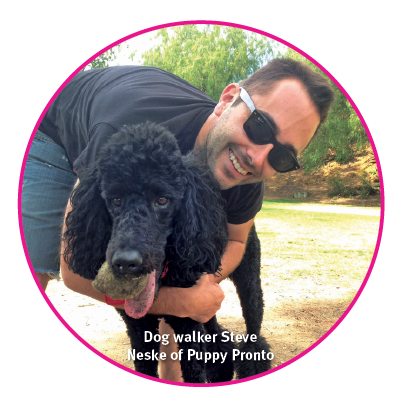
Being a dog walker is about much more than just walking dogs, says Steve Neske, who opened the dog walking and pet services company Pronto Puppy in Los Angeles with his wife two years ago.
To get started, it's about putting boots on the ground and connecting with dog owners in a bid to win their trust and business. And that means getting out there with flyers, business cards, and a smile. You also need a trusted web presence.
“A website and a listing on Yelp are virtually must-haves in this day and age, and it doesn't hurt to run some Google ads,” says Neske.
Walkers should also be bonded and insured in case of an emergency.
Neske says being a dog walker affords a great deal of autonomy and flexibility, but it's no cakewalk. Generally, there are no benefits and no paid sick days.
“If you can't make a walk then that dog doesn't get a walk that day, which is no good,” he says.
Ditto on holidays. Some of Pronto Puppy's busiest days are holidays and long weekends.
Your earnings as a dog walker depend on where you live, how much you want to work, and how many dogs you're willing (and able) to walk. Some companies pride themselves on walking one pooch at a time, while others specialize in pack walks or group hikes.
For Neske, success has come through being able to take on more business by hiring more and more walkers.
“The sky is the limit,” he says.
He says to rethink your career path if you believe that walking dogs is going to be an easy cash grab, or something you do casually.
“It's more than meets the eye. But if you put in the work, it's a wonderful way to spend time with dogs while making money.”
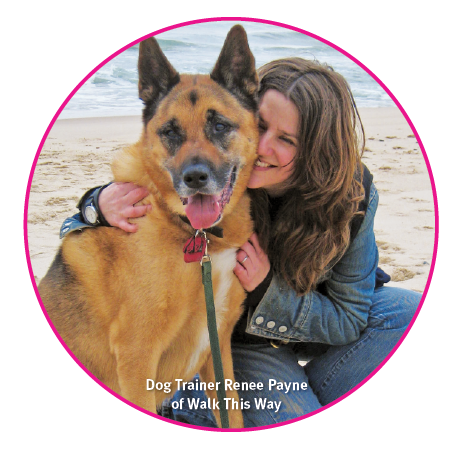
With dog trainers charging up to $125 an hour in New York City, certified professional dog trainer Renee Payne says many people get into the industry thinking they’re going to get rich quickly, but that’s not the case. After subtracting travel time, research and paper work, the veteran canine therapist and trainer says most people can expect to make $20 an hour or so to start.
Rates also vary on whether you can sell group training packages or offer private lessons and puppy school. To satisfy long-distance clients, Payne, who owns Brooklyn-based positive-reward-based training company Walk This Way, offers private sessions by phone or Skype in addition to private and group classes.
And don’t underestimate the amount of people skills you’ll need for the dog-focused career. As important as the training itself is making the owners feel relaxed and comfortable, and confident in your abilities.
“The dogs aren’t paying you, the people are,” notes Payne.
She says the highlight of her job is seeing her canine clients and owners learn together—and seeing their bond strengthen.
Payne admits most clients don’t practice their training as much as they should, “but that’s okay,” though she does get frustrated when they don’t take her training advice and blame her for the problems they have with their dog.
“It’s hard when they say they ‘can't’ do anything I suggest, and proceed to tell me why it won't work without even trying it,” she says.
“Fortunately, the overwhelming majority of my clients are wonderful and also want to see results and they do the work to get there with my help.”
There are lots of seminars and online courses to attend if you’re interested in becoming a trainer, but the best way to educate yourself is spending time with a trusted trainer. Some professionals offer programs and internships where, for a fee, you can shadow them for a number of months.
“You get to see real clients and all of the various problems and personalities you might encounter,” says Payne.
You’ll also need to take a certification test through the Certification Council for Professional Dog Trainers.
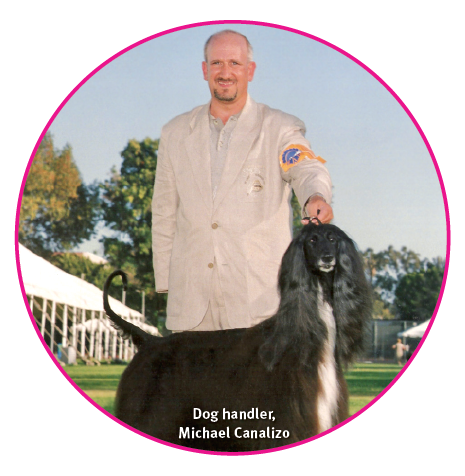
With over 300 Best in Show wins under his belt, professional dog handler Michael Canalizo holds the title of top winning hound of all time with one of his prized Afghan Hounds, the impressively named Ch. Tryst of Grandeur.
Coming from a long line of dog sport enthusiasts—his parents were dog breeders and show judges—Canalizo, now a director at the American Kennel Club, admits not everyone was “born” into the sport the way he was. He recommends shadowing a veteran handler or finding a mentor if you want to jump into this hands-on career.
“You can start out working for an established handler and ‘break out’ on your own after a solid background working with a professional,” the second-generation Afghan breeder says.
Becoming a dog handler starts with a “passion for dogs at every level,” he says, but it’s much more than that. Handlers are given a great responsibility to care for and condition an animal that is 100 per cent dependent on them.
“Being up to care for your clients’ dogs every day in the wee hours without exception makes a lazy day in bed few and far between,” he says.
There are also substantial travel demands. In addition to the long days and hours of preparing dogs for the show circuit, it’s completely realistic to attend about 100 shows
a year—even 150.
“My biggest year, I attended 151 shows and got in the Best In Show ring 115 times,” says Canalizo.
But the job rewards are obvious: seeing a young pup progress into a show winner is a great boon, not to mention the strong bond you develop with your charges.
“Having those special dogs that connect with you resonates to stellar performances that both the novice spectator or the veteran exhibitor can see,” he says.
Canalizo says top handlers can make $100,000 or more annually, but novice handlers shouldn’t expect a huge payday early on. Earnings depend on years of hard work and, hopefully, winning shows.
There’s also room in the profession to branch out into other areas. After decades of dedication and experience, Canalizo moved into show judging, carefully examining purebreds on the standards of excellence he strove for in his own career.

Sonja Banman decided to open her own small dog daycare after being unhappy with the options available for her nine-pound pup, Charlie Girl.
“Most of the facilities had larger dogs and I was looking for a daycare for small dogs only,” says the owner of Pipsqueak Pups. Her facility in Vancouver, BC stands out by only accepting dogs under 35 pounds, something her clients greatly appreciate.
While you might think owning a daycare is mostly just playing with dogs, that's not the case. Banman recommends working in a facility to understand what's involved in running a daycare before investing your time and money into opening your own.
“It's also about having the necessary management skills, industry expertise, technical skills, passion for dogs, finance and, of course, a long-term vision to grow and succeed.”
For daycare owners like Sonja, it’s also a 24-hour job. She offers home boarding, where her canine clients stay with her or her employees when their owners go out of town.
“The dogs get to sleep on our couches, in front of our fireplaces. They’re not locked in a kennel,” she says.
Loving dogs is a must—you'll be with them 12 hours a day, minimum—but good people skills are also key. You have to relate to dog owners and, more importantly, gain their trust and loyalty. You also need to get pet first aid certification.
Marketing also plays a role in having a successful daycare. Sonja built her business by visiting dog parks and walking around neighbourhoods after-hours and on weekends to introduce herself to pet owners and hand out business cards. She also logs several hours each day posting photos and updates on her website, Facebook page, and Twitter.
“It's important that owners can see their pets in the daycare setting and know they’re safe and having fun,” she says.
Zoning regulations and bylaws factor into where you can open a dog daycare, and rules vary by city. The daycare should have lots of small furniture, cushions and blankets for the small-breeds to cuddle with, Banman says, and be close to green spaces and parks for the pooches to enjoy on their walks. The dogs will need to go out a minimum of three times a day.
At her facility the dogs also have constant access to a large outdoor space and can come and go as they please.
Pet lovers considering opening their own dog daycare should prepare themselves for hard work and lean times while you're building the business. She says the best thing about working in daycare is getting to know all of the wonderful dogs, and understanding their unique personalities.
“They become like your own pets after a while. I am truly lucky to watch them grow and become more socialized, and it's especially heartwarming to see the shy rescues make a complete turnaround,” she says.
Join the newsletter and never miss out on dog content again!
"*" indicates required fields
By clicking the arrow, you agree to our web Terms of Use and Privacy & Cookie Policy. Easy unsubscribe links are provided in every email.
